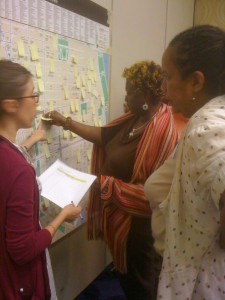Sharing resources and learnings with Georgia colleagues
This past week, David Lee and I traveled to Atlanta to provide trainings for the Georgia Network to End Sexual Assault (GNESA) on primary prevention and bystander intervention. Laura Fidler of the New York City Alliance to End Sexual Assault joined us to provide training on community engagement and to share her experience working on Project Envision. After weeks of conversations about budget cuts and intense media coverage about child sexual abuse at Penn State among other institutions, the positive response we received from the participants of the two-day conference was inspiring and uplifting, reinvigorating my passion for sexual assault prevention work.

The 60 participants came from a wide range of backgrounds but shared a common goal: ending sexual violence in their communities. David started the conference by framing primary prevention, and exploring where our movement has been and the directions in which it is headed. One of the most valuable pieces of this workshop was the conversation about the way we, as prevention educators, can foster behavior change. Take home message? Focus on community level change efforts. Primary prevention is about changing social norms, attitudes, beliefs and behaviors in a community. Response from the crowd? Overwhelmingly positive — David’s message reaffirmed what they knew to be true from the work they are currently doing and wanted to focus on in their communities.
I took on the second half of day 1 by addressing bystander intervention and the way that bystander intervention curricula and concepts help to create community change. We, as educators, are able to engage the entire community as potential bystanders, instead of being potential perpetrators and potential victims. Bystander intervention also opens up the doors to engaging men and boys in new ways, creating a social movement and empowering community members with concrete action steps to address sexual violence. Bystander intervention also challenges us to confront our own tolerance of violence, as it calls on us to intervene each and every time we witness violence or the precursors to violence. What a heavy load to carry alone! My take home message: The more people who you can engage in bystander intervention work, the greater the number of people who will take on community safety as their responsibility. We can create a paradigm shift together, as a united community, intolerant of violence.
Laura followed on day 2 with concrete action steps for engaging your community in these efforts. Laura spoke about her work on Project Envision. In conjunction with 11 of the city’s rape crisis programs, in 2008 the Alliance initiated the second phase of Project ENVISION, a six-year sexual violence primary prevention demonstration project. In this phase, the Alliance trained community researchers in participatory action research methods to conduct needs assessments in three New York City communities: Manhattan’s Lower East Side, the South Bronx and Williamsburg, Brooklyn. Participatory action research was utilized as a community mobilizing strategy. By emphasizing meaningful community involvement at all stages of the research and generating awareness about sexual violence prevention, this approach acts as a component of a primary prevention intervention. Laura conducted an exercise called asset mapping, where she invited participants to examine a map of the Lower East Side and determine how they would locate and identify a number of resources and assets (see picture below). She encouraged participants to reframe and rethink their community assessment methods to identify strategic partnerships, identify influential community members and organizations, and to create an ongoing dialogue with the neighborhood through interviews and focus groups. Take home message? Work with and alongside your community. Give them the power to voice concerns, opinions, goals, challenges and successes. Engaging your community in the process of creating solutions to end sexual violence is essential.

Stay tuned for our resource lists from the presentations to get more information on primary prevention, bystander intervention and community engagement!

Hey David… Great story